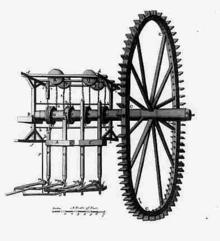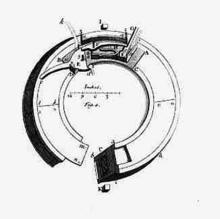Thomas Holland
The Rev Thomas Holland's pumping engine
 In 1716 the Rev. Thomas
Holland, Minister for Amesbury, sought a patent for a water-raising device.
This engine, based on an undershot waterwheel, is believed to be the one referred to in 1763 by the 18th C French philosopher John Theophilus Desaguliers in his Course of Experimental Philosophy,
where he describes the pump and its action.
In 1716 the Rev. Thomas
Holland, Minister for Amesbury, sought a patent for a water-raising device.
This engine, based on an undershot waterwheel, is believed to be the one referred to in 1763 by the 18th C French philosopher John Theophilus Desaguliers in his Course of Experimental Philosophy,
where he describes the pump and its action.
Holland's engine transformed
the rotational power of the wheel into pressurising water along pipes to
give a continuous pulsating flow. This was done by ‘curiously
contrived’ locks and collars and forcers, or pumps, with valves to
direct the water flow into pipes.
Desaguliers gives an illustration
of this engine which is believed to be the one demonstrated to Lord
Tylney. The description tells us that the waterwheel was 30 ft in
diameter and the main shaft 24 ft long and 24 inches in diameter. The
ingenious rings or collars were 3 ft in diameter
and the pumps were 7 ft long with a diameter of 6 inches. The principal
construction was in wood, with metal triggers and locks for the collars,
similarly for the pumps, chains and pipework. The waterwheel was
undershot, with a fall of 7 ft.
This pump seems to have been
designed to raise water 70 ft to the house and, or, 80 ft to Lord
Tylney’s gardens. Rotating at 5 rpm, it supplied 95 hogsheads (hhd)* per
hour to the house and, at 3 rpm, 47 hogsheads to the gardens.
A similar but smaller version was erected and demonstrated for the Earl of Pembroke at Wilton, though no records exist of that.
The pump was clearly not a device that lent itself to easy
transportation, construction and demonstration. Desaguliers himself
acknowledges the ingenuity of the design, but is critical of the pump’s
likely efficiency, with many sources of friction and loading to reduce
its initial mechanical advantage. He suspects that Holland went by guess
work rather than calculation and points out that there is the potential
for considerable water loss in the forcers if the leather valves are not
in good condition. Parts of the pump are inappropriately small,
resulting in considerable friction in the flow of water, and, if the
final pipe dimensions were greater, the water velocity and efficiency
would improve.
 The Rev. Thomas Holland may have gained inspiration
and testing facilities at the nearby West Mill, but how and where would
the 24 ft shaft have been turned to obtain acceptable accuracy for the
patent application? This is just one of the many questions that remain
unanswered about this intriguing Wiltshire clergyman and other
inventions of his.
The Rev. Thomas Holland may have gained inspiration
and testing facilities at the nearby West Mill, but how and where would
the 24 ft shaft have been turned to obtain acceptable accuracy for the
patent application? This is just one of the many questions that remain
unanswered about this intriguing Wiltshire clergyman and other
inventions of his.
Peter Goodhugh
(Part reproduced by permission from Peter Goodhugh's article in the Wiltshire Local History Forum Newsletter, August 2007)
* Old Imperial Gallon measure. 1 Hogshead = 54 gallons or 6 firkins.